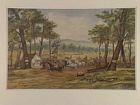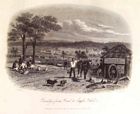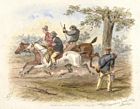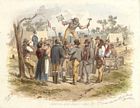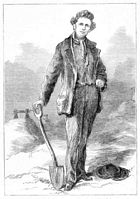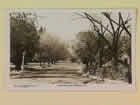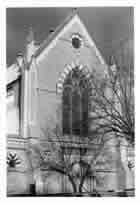- Alternative Names
- Sandhurst
The Bendigo Diggings grew out of the Mount Alexander Diggings, and were at first regarded as an extension of that rich surface field. Mystery surrounds the first discovery of gold at Bendigo, and a rewards committee set up in 1890 was never able to make a decision between thirteen people who all claimed to have been the first. Two women, Mrs Kennedy and Mrs Farrell, were certainly amongst the first to pan for gold on Bendigo Creek, on the Ravenswood sheep run. On 13 December 1851 the Argus carried the first public announcement of the discovery of gold at Bendigo, and many diggers from the nearby Forest Creek diggings tried their luck.
Life on the diggings that summer was rough; drinking water was scarce and men went for weeks without washing. Flies spread disease and dysentery was rife. Early in May the drought promptly turned and the whole diggings became a quagmire.
On 8 May 1852 Bendigo saw its biggest rush yet, to Red Hill, at what was to become the famous Eaglehawk Gully. By June, it is said that five to six thousand diggers were arriving each week. Large nuggets were found at the Whipstick, such as the Dascombe, the Victoria, and the Whipstick, weighing 573 ounces.
William Howitt estimated that not more than half the diggers at Bendigo in 1853 were paying the licence fee – despite the hype of riches on the field, many diggers still struggled to cover the thirty shillings a month fee. Although Bendigo Creek itself had no government camp in the early months, Commissioner Cockburn was stationed on a rise behind the Sheepwash and Commissioner Gilbert on Bullock Creek. Commissioner Gilbert relocated his camp in May 1852, to a ridge overlooking the creek, almost in the centre of the valley, and soon town life began to revolve around this camp.
On 18 January 1853 La Trobe announced that the township would be called Sandhurst. The Select Committee of 1890, in charge of determining who found the first gold in the region, was also given the task of determining the origin of the city’s name. The most common explanation is that it was named after a local, who was nicknamed ‘Bendigo’ after the British prize-fighter of the time.
Bendigo’s first newspaper appeared in December 1853.
As early as 1852 a slab church was erected near Golden Point, and by March the following year it was joined by chapels at Golden Gully and the Commissioner’s Camp. By August 1853 the Mount Alexander Road, previously in terrible condition, had become one of the best in the colony. In 1854 the first Cobb and Co. coaches appeared on the Sandhurst to Melbourne run. With this improved access the number of women on the goldfields increased.
Early in 1854 the Surveyor General arrived with a team to plan a permanent township in the Bendigo Valley. The first Sandhurst land sales were held the following August, and allotments around the centre of the township, particularly those fronting Pall Mall, were quickly snapped up.
1853 was the richest year the Bendigo goldfield was to know, but the alluvial riches were abating. Very soon alluvial mining was being overshadowed by the discovery of Bendigo’s quartz reefs and the clamour to exploit their potential. As early as 1852-53, reefs were already being worked at Bendigo and Eaglehawk. Within two years, quartz reefing overtook alluvial mining as the main focus of gold mining at Bendigo. Bendigo became a city in 1871.

